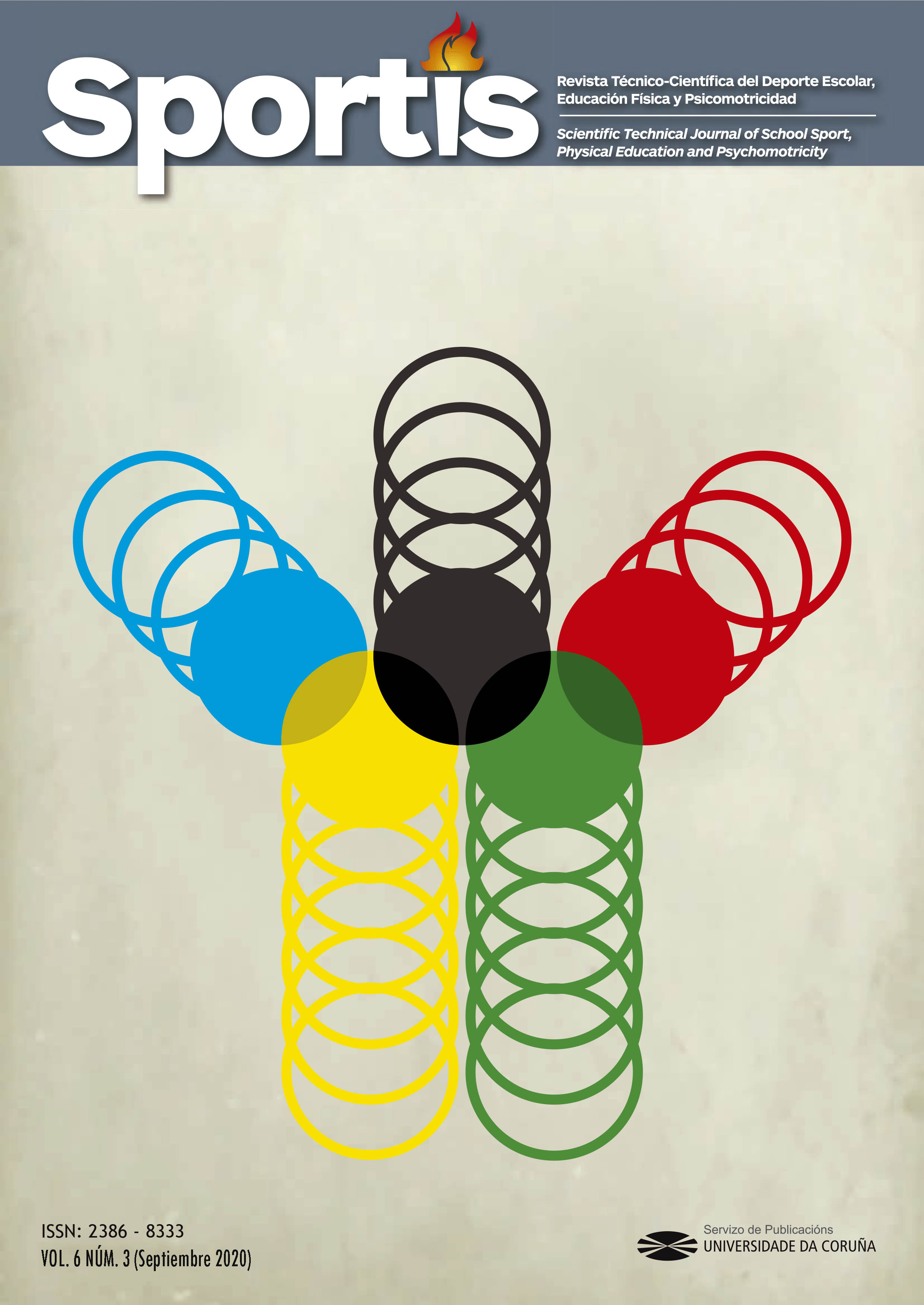Assessment of motor coordination in students of Early Childhood Education. Developmental Coordination Disorder
Main Article Content
Abstract
The lacking in coordination skills development and acquisition, known as Developmental Coordination Disorder (DCD) or developmental dyspraxia, is a motor disorder not attributable to any type of disability or neurological disorder of movement alteration, but which affects functions such as speech, language, writing or attention. Its influence is estimated to be 5-15% in school-age children, with the highest prevalence in boys. A total of 91 5-year-old students (x= 5.83; SD=0.33) from the province of Malaga participated in the study. Acquisition levels of motor coordination skills were evaluated, identifying children in a normal situation, at risk of psychomotor decline or with suspected DCD, and the differences in motor performance according to sex were analyzed. For the assessment of motor coordination, the Spanish version of the Movement Assessment Battery for Children - Second Edition (MABC-2) was used. The results identify 6.56% of children as DCD and 4.67% at risk. Regarding the differences associated with sex, girls achieved significantly higher scores in manual dexterity and balance areas, while boys achieved higher scores, although not significantly, in aiming and catching area.
Keywords:
Downloads
Article Details
References
Almaas, R., Jensen, U., Loennecken, M. C., Tveter, A. T., Sanengen, T., Scholz, T., & Holm, I. (2015). Impaired Motor Competence in Children With Transplanted Liver. Journal of Pediatric Gastroenterology and Nutrition, 60(6), 723-728. DOI: https://doi.org/10.1097/MPG.0000000000000757
Asociación Americana de Psicología (2014). Manual diagnóstico y estadístico de los trastornos mentales. Madrid: Panamericana.
Ayán, C. (2017). La valoración de la condición física en la educación infantil: Principales tests de aplicación: Paidotribo.
Blank, R., Smits-Engelsman, B., Polatajko, H., & Wilson, P. (2012). European Academy for Childhood Disability (EACD): Recommendations on the definition, diagnosis and intervention of developmental coordination disorder (long version)*. Developmental Medicine & Child Neurology, 54(1), 54-93. DOI: https://doi.org/10.1111/j.1469-8749.2011.04171.x
Bo, J., Colbert, A., Lee, C.-M., Schaffert, J., Oswald, K., & Neill, R. (2014). Examining the relationship between motor assessments and handwriting consistency in children with and without probable developmental coordination disorder. Research in developmental disabilities, 35(9), 2035-2043. DOI: https://doi.org/10.1016/j.ridd.2014.04.027
Delgado-Lobete, L., & Montes-Montes, R. (2017). Perfil y desarrollo psicomotor de los niños españoles entre 3 y 6 años. Sportis, 3(3), 454-470. DOI: https://doi.org/10.17979/sportis.2017.3.3.2002
Flatters, I., Hill, L. J. B., Williams, J. H. G., Barber, S. E., & Mon-Williams, M. (2014). Manual control age and sex differences in 4 to 11 year old children. PloS one, 9(2), e88692. DOI: https://doi.org/10.1371/journal.pone.0088692
Gomez, A., Piazza, M., Jobert, A., Dehaene-Lambertz, G., Dehaene, S., & Huron, C. (2015). Mathematical difficulties in developmental coordination disorder: Symbolic and nonsymbolic number processing. Research in Developmental Disabilities, 43, 167-178. DOI: https://doi.org/10.1016/j.ridd.2015.06.011
Gomez, A., Piazza, M., Jobert, A., Dehaene-Lambertz, G., & Huron, C. (2017). Numerical abilities of school-age children with Developmental Coordination Disorder (DCD): A behavioral and eye-tracking study. Human movement science, 55, 315-326. DOI: https://doi.org/10.1016/j.humov.2016.08.008
Harrowell, I., Hollén, L., Lingam, R., & Emond, A. (2018). The impact of developmental coordination disorder on educational achievement in secondary school. Research in developmental disabilities, 72, 13-22. DOI: https://doi.org/10.1016/j.ridd.2017.10.014
Henderson, S. E. (2012). Batería de evaluación del movimiento para niños-2 : (MABC-2). In D. A. Sugden, A. L. Barnett, L. M. Ruiz Pérez, & J. L. Graupera Sanz (Eds.), MABC-2. Madrid: Pearson.
Houwen, S., van der Veer, G., Visser, J., & Cantell, M. (2017). The relationship between motor performance and parent-rated executive functioning in 3- to 5-year-old children: What is the role of confounding variables? Human Movement Science, 53, 24-36. DOI: https://doi.org/10.1016/j.humov.2016.12.009
Huau, A., Velay, J.-L., & Jover, M. (2015). Graphomotor skills in children with developmental coordination disorder (DCD): Handwriting and learning a new letter. Human movement science, 42, 318-332. DOI: https://doi.org/10.1016/j.humov.2015.03.008
Leonard, H. C., & Hill, E. L. (2015). Executive difficulties in developmental coordination disorder: methodological issues and future directions. Current Developmental Disorders Reports, 2(2), 141-149. DOI: https://doi.org/10.1007/s40474-015-0044-8
Lingam, R., Hunt, L., Golding, J., Jongmans, M., & Emond, A. (2009). Prevalence of developmental coordination disorder using the DSM-IV at 7 years of age: A UK population–based study. American Academy of Pediatrics, 123, e693-e700. DOI: https://doi.org/10.1542/peds.2008-1770
Magalhães, L. C., Cardoso, A. A., & Missiuna, C. (2011). Activities and participation in children with developmental coordination disorder: A systematic review. Research in Developmental Disabilities, 32(4), 1309-1316. DOI: https://doi.org/10.1016/j.ridd.2011.01.029
Missiuna, C., Moll, S., King, S., King, G., & Law, M. (2007). A Trajectory of Troubles. Physical & Occupational Therapy In Pediatrics, 27(1), 81-101. DOI: https://doi.org/10.1300/J006v27n01_06
Missiuna, C., Moll, S., Law, M., King, S., & King, G. (2006). Mysteries and Mazes: Parents' Experiences of Children with Developmental Coordination Disorder. Canadian Journal of Occupational Therapy, 73(1), 7-17. DOI: https://doi.org/10.2182/cjot.05.0010
National Association for Sport and Physical Education (2012). 2012 shape of the nation report: Status of physical education in the USA: American Alliance for Health.
Organización Mundial de la Salud (2010). Recomendaciones mundiales sobre actividad física para la salud. Suiza: Organización Mundial de la Salud.
Piek, J. P., Hands, B., & Licari, M. K. (2012). Assessment of Motor Functioning in the Preschool Period. Neuropsychology Review, 22(4), 402-413. DOI: https://doi.org/10.1007/s11065-012-9211-4
Plata, R., & Garbiñe, B. (2009). El niño con trastorno del desarrollo de la coordinación ¿Un desconocido en nuestra comunidad? Norte de Salud Mental, 8, 18-30.
Prunty, M., Barnett, A. L., Wilmut, K., & Plumb, M. (2016). Visual perceptual and handwriting skills in children with Developmental Coordination Disorder. Human movement science, 49, 54-65. DOI: https://doi.org/10.1016/j.humov.2016.06.003
Rivard, L., Missiuna, C., McCauley, D., & Cairney, J. (2014). Descriptive and factor analysis of the Developmental Coordination Disorder Questionnaire (DCDQ ‘07) in a population‐based sample of children with and without Developmental Coordination Disorder. Child: care, health and development, 40(1), 42-49. DOI: https://doi.org/10.1111/j.1365-2214.2012.01425.x
UNESCO (2015). Educación Física de Calidad. Guía para los responsables políticos. Francia: UNESCO.
Valentini, N. C., Oliveira, M. A., Pangelinan, M. M., Whitall, J., & Clark, J. E. (2017). Can the MABC discriminate and predict motor impairment? A comparison of Brazilian and American children. International Journal of Therapy and Rehabilitation, 24(3), 105-113. DOI: https://doi.org/10.12968/ijtr.2017.24.3.105
Wenzel, A. (2017). The sage encyclopedia of abnormal and clinical psychology (Vol. 1): SAGE Publications. DOI: https://doi.org/10.4135/9781483365817







